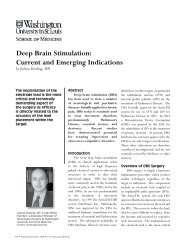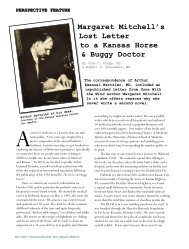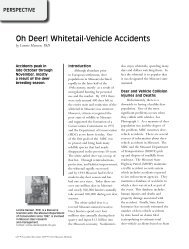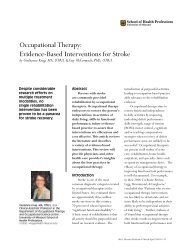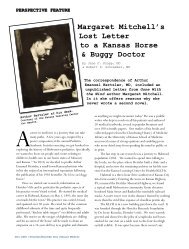Tick-Borne Febrile Illnesses Lacking Specific Symptoms
Tick-Borne Febrile Illnesses Lacking Specific Symptoms
Tick-Borne Febrile Illnesses Lacking Specific Symptoms
Create successful ePaper yourself
Turn your PDF publications into a flip-book with our unique Google optimized e-Paper software.
CASE REPoRT<br />
When time is ‘ticking’ away, don’t be clueless;<br />
severity of illness Is a diagnostic clue<br />
<strong>Tick</strong>-<strong>Borne</strong> <strong>Febrile</strong> <strong>Illnesses</strong> <strong>Lacking</strong><br />
<strong>Specific</strong> <strong>Symptoms</strong><br />
by William V. Stoecker, MD, David A. Calcara, BS, Joseph M. Malters, MD,<br />
Monica Clonts, RN, BSN & E. Dale Everett, MD<br />
When treatment is<br />
delayed, some patients<br />
can progress to severe<br />
multisystem disease<br />
with toxic shock-like<br />
syndrome.<br />
William V. Stoecker, MS, MD, MSMA<br />
member since 1984, is a Clinical<br />
Assistant Professor, Division of<br />
Dermatology, at the University of<br />
Missouri School of Medicine, and<br />
practices dermatology in Rolla.<br />
David A. Calcara, BS, is a first-year<br />
medical student at the University of<br />
Missouri School of Medicine. Joseph<br />
M. Malters, MD, MSMA member<br />
since 2003, practices dermatology<br />
in Rolla. Monica Clonts, RN, BSN, is<br />
a nurse at the Phelps County Health<br />
Department. E. Dale Everett, MD,<br />
is Emeritus Professor of Infectious<br />
Diseases, Department of Internal<br />
Medicine, University of Missouri<br />
School of Medicine.<br />
Contact: wvs@mst.edu<br />
304 w July/August 2009 w 106:4 Missouri Medicine<br />
Abstract<br />
We report here one case of<br />
tularemia, one case of human<br />
monocytic ehrlichiosis, and<br />
one case of febrile illness most<br />
consistent with tularemia with<br />
titers suggestive of Rocky<br />
Mountain spotted fever in<br />
residents of three south-central<br />
Missouri counties. All three<br />
cases had with nonspecific<br />
symptoms of a febrile illness. All<br />
three patients had a history of<br />
a tick bite, common in southcentral<br />
Missouri, but only<br />
two patients reported the tick<br />
bite when first seen. In these<br />
three cases, the severity of the<br />
illness provided a clue that led<br />
to a diagnosis of tick-borne<br />
febrile illnesses by confirmatory<br />
serology in two cases. It is very<br />
important that physicians be<br />
aware of these diseases in the<br />
spring and summer months.<br />
Introduction<br />
Missouri has a high incidence<br />
of three tick-borne febrile illnesses:<br />
Rocky Mountain spotted fever,<br />
tularemia, and human monocytic<br />
ehrlichiosis. In the diagnosis of these<br />
tick-borne febrile illnesses, it is often<br />
helpful to have specific signs and/<br />
or laboratory findings. For Rocky<br />
Mountain spotted fever, a purpuric<br />
exanthem is the most prominent<br />
finding leading to the diagnosis. For<br />
tularemia, one of the most useful<br />
signs is lymphadenopathy. For<br />
ehrlichiosis, the combination of<br />
leukopenia and thrombocytopenia<br />
can serve to suggest this diagnosis<br />
rather than other tick-borne<br />
illnesses. However, patients may<br />
lack these findings in the early stages<br />
of their illness.<br />
We present a series of three<br />
patients who presented with<br />
severe but nonspecific findings of<br />
their illness. In all subjects, the<br />
initial serologic studies were nondiagnostic,<br />
as is routinely the case.<br />
Convalescent serology established the<br />
diagnosis in two of these cases.
Table 1. Case Definitions of Three Causes of <strong>Tick</strong>-<strong>Borne</strong> <strong>Febrile</strong> Eruptions1<br />
Table 1<br />
Case Definitions of Three Causes of <strong>Tick</strong>-<strong>Borne</strong> <strong>Febrile</strong> Eruptions 1<br />
Name Clinical Presentation Laboratory Results<br />
Ehrlichiosis Fever and one or more of the following:<br />
Headache<br />
Myalgia<br />
Anemia<br />
Leukopenia<br />
Thrombocytopenia<br />
Any hepatic transaminase elevation.<br />
Rocky Mountain<br />
Spotted Feve r<br />
Case One: Undiagnosed<br />
Acute <strong>Febrile</strong> Illness<br />
In July, 2007, a 49-year-old male<br />
presented at an urgent care clinic in<br />
Jefferson City with a one-day history<br />
of fever, headache, severe myalgia<br />
and profuse sweating. During the<br />
preceding day, he changed clothes<br />
several times because he was sweating<br />
so profusely that his “clothes kept<br />
getting soaked.” He said, “no<br />
one ever wants to feel as bad as I<br />
did.” Six days previously, he was<br />
bitten by a tick. On examination,<br />
he had a temperature of 101° F.<br />
and a small red macule on the<br />
Fever and one or more of the following:<br />
Rash<br />
Headache<br />
Myalgia<br />
Anemia<br />
Thrombocytopenia<br />
Any hepatic transaminase elevation.<br />
Tularemia One or more of the following:<br />
Evidence or history of a tick or deerfly bite<br />
Exposure to tissues of a mammalian host of<br />
F.tularensis,<br />
Exposure to potentially contaminated water.<br />
Common symptoms:<br />
Skin ulcers<br />
Swollen<br />
Painful lymph glands<br />
Inflamed eyes<br />
Sore throat<br />
Mouth sores<br />
Diarrhea<br />
Pneumonia<br />
If the bacteria are inhaled, symptoms can include<br />
abrupt onset of fever, chills, headache, muscle<br />
aches, joint pain, dry cough, and progressive<br />
weakness.<br />
People with pneumonia can develop chest pain,<br />
difficulty breathing, bloody sputum, and<br />
respiratory failure.<br />
right groin area, the site of the<br />
tick bite. Rash, pharyngitis, and<br />
lymphadenopathy were absent.<br />
No laboratory evaluations were<br />
performed. A diagnosis of possible<br />
tick-related illness was made and<br />
therapy with doxycycline 100 mg<br />
b.i.d. for 10 days was initiated.<br />
Although his symptoms were greatly<br />
improved after 24-48 hours of<br />
antibiotic therapy, some degree of<br />
fever, headache, malaise and myalgia<br />
persisted. On the third day of<br />
illness, the patient was seen at his<br />
physician’s office with a fever of<br />
100.4° F. Gentamicin 80 mg IM<br />
<strong>Tick</strong>-<strong>Borne</strong> <strong>Febrile</strong> Illness Severity Page 11<br />
Fourfold change in Ig-G-specific antibody<br />
titer or<br />
Detection of E. chaffeensis DNA in clinical<br />
specimen or<br />
Demonstration of ehrlichial antigen in a<br />
biopsy sample by immunohistochemical<br />
methods or<br />
Isolation of E. chaffeensis from a clinical<br />
specimen in cell culture<br />
Fourfold change in Ig-G-specific antibody<br />
titer or<br />
Detection of R. rickettsii DNA in clinical<br />
specimen or<br />
Demonstration of spotted fever group<br />
antigen in a biopsy sample by<br />
immunohistochemical methods or<br />
Isolation of R. rickettsii from a clinical<br />
specimen in cell culture<br />
Isolation of F. tularensis in a clinical specimen<br />
or<br />
Fourfold or greater change in serum<br />
antibody titer to F. tularensis antigen<br />
was given. On the fourth day of<br />
illness, he returned to his physician’s<br />
office, with unabated symptoms. His<br />
temperature was 98.2 F. (after taking<br />
acetaminophen). He was found to<br />
have a swollen lymph node in the<br />
right groin area. He received another<br />
dose of gentamicin 80 mg IM. At<br />
this time, an immunofluorescent<br />
antibody immunoglobulin G titer<br />
for Rocky Mountain spotted fever<br />
(RMSF IgG-IFA) was obtained.<br />
On the thirteenth day after illness<br />
onset, the patient returned to his<br />
physician’s office, and stated that all<br />
symptoms had resolved and he felt<br />
106:4 Missouri Medicine w July/August 2009 w 305
well. The RMSF IgG-IFA result was<br />
1:128. An additional 10-day course<br />
of doxycycline, 100 mg b.i.d., was<br />
initiated. The convalescent RMSF<br />
serology was not obtained. The<br />
case was clinically most compatible<br />
with ulceroglandular tularemia,<br />
with a single serology suggestive of<br />
RMSF. Without convalescent RMSF<br />
serology or any testing for tularemia,<br />
a diagnosis could not be made. 1<br />
Case Two:<br />
Confirmed Tularemia<br />
In June, 2008, a 67-yearold<br />
male Phelps County resident<br />
attended a dermatology clinic for a<br />
routine skin follow-up examination.<br />
He had been “doing yard work”<br />
four to five days before the onset of<br />
illness. On the first day of illness, he<br />
had vomited once. On the second<br />
day of illness, he had awakened<br />
with a headache, nausea, and chills,<br />
progressing to further vomiting and<br />
worsening prostration. On a clinic<br />
visit on the second day, he had a<br />
temperature of 100.3º Fahrenheit,<br />
pulse of 96, and a blood pressure of<br />
128/88, and felt too ill to stay to see<br />
the physician. On the third day of<br />
illness, his wife partially removed a<br />
tick from the left upper back, later<br />
identified from an Internet image<br />
as a lone star tick (Amblyomma<br />
americanum, adult female). On<br />
the fourth day of illness, the fever<br />
reached 103º F and prostration<br />
became so severe that his wife<br />
transported him to an urgent care<br />
facility where he was found to have<br />
orthostatic hypotension. A diagnosis<br />
of dehydration due to viral illness<br />
was made and he was referred to<br />
the emergency room for intravenous<br />
fluid replacement, which was<br />
administered without laboratory<br />
306 w July/August 2009 w 106:4 Missouri Medicine<br />
testing. On the fifth day of illness,<br />
the dermatology clinic manager<br />
determined a history of a tick bite<br />
and suggested that he return to the<br />
dermatology clinic. He presented<br />
with symptoms of a severe headache,<br />
photophobia, fatigue, and malaise<br />
that the patient described as “feeling<br />
awful.” There were no symptoms<br />
of cough, diarrhea, or conjunctivitis,<br />
and no history of contact with wild<br />
animals. Temperature was 101.2º<br />
F. There was no rash, no ulcer, and<br />
no lymphadenopathy. A persistent<br />
excoriated papule was present at the<br />
site of the partially removed tick.<br />
The remainder of the examination<br />
was unremarkable. A diagnosis<br />
of tick-borne febrile illness was<br />
made. Further laboratory evaluation<br />
included an acute complement<br />
fixation titer for F. tularensis of <<br />
1:20, immunofluorescent RMSF<br />
IgG and IgM titers of < 1:64,<br />
and negative Ehrlichia chaffeensis<br />
antibodies (IgG < 1:64 and IgM<br />
< 1:20). A two-week course of<br />
doxycycline therapy 100 mg b.i.d.<br />
was initiated. The night after this<br />
therapy was begun, the patient<br />
sweated profusely. The next day he<br />
felt much better and was afebrile on<br />
that day and subsequently. Three<br />
weeks later, repeated RMSF and<br />
Ehrlichia chaffeensis titers were<br />
unchanged. A diagnosis of tularemia<br />
was made when an F. tularensis<br />
convalescent titer of 1:2560, a 128fold<br />
rise, was obtained.<br />
Case Three: Confirmed<br />
Human Monocytic<br />
Erlichosis<br />
In July, 2008, a 77-year-old<br />
female Crawford County resident<br />
felt quite ill and saw her physician<br />
with fever, malaise, and myalgia. She<br />
subsequently described the severity<br />
of the illness: “I have never been that<br />
sick before and I don’t ever want to<br />
be that sick again. I was sick for two<br />
weeks. My head hurt. I hurt all over.<br />
I had a fever for four days and I had<br />
no appetite.” At presentation, the<br />
patient recounted recent tick bites<br />
and a four-day history of fever up to<br />
102° F. Her white blood cell count<br />
was 11.4 X 10³/μL (normal 4/0-10.5<br />
X 10³/μL) and the platelet count was<br />
159 X 10³/μL (normal 150-450 X<br />
10³/μL). Hepatic transaminases<br />
were elevated, with AST 142 (12-<br />
32) and ALT 460 (8-46). The<br />
hepatitis panel was all negative.<br />
The indirect immunofluorescence<br />
assay for IgG antibodies (IgG-IFA)<br />
to Ehrlichia chaffeensis was < 1:20.<br />
When repeated three weeks later,<br />
the IgG-IFA to Ehrlichia chaffeensis<br />
had risen to ≥1:1024, which along<br />
with the clinical history of fever<br />
and a headache, confirmed this case<br />
of human monocytic ehrlichiosis<br />
(See Table 1). The patient was<br />
treated with a two-week course of<br />
doxycycline, 100 mg b.i.d., rapidly<br />
felt better, and recovered fully. The<br />
next month, liver enzymes, white<br />
blood cell and platelet counts were<br />
all normal.<br />
Discussion<br />
All three cases illustrate the<br />
nonspecific early presentations of<br />
tick-borne febrile illnesses. Here<br />
we give a brief review of early<br />
presentations of these illnesses<br />
and the issue of diagnostic delay<br />
as it pertains to disease course and<br />
response to therapy. In all three<br />
illnesses, failure to give timely<br />
therapy may result in a severe or even<br />
fatal course.<br />
In one recent series of RMSF
in children, delays in diagnosis were<br />
found to be “unacceptably common,”<br />
with fatality rates of 3% still observed<br />
for this rickettsial illness. 2 In this<br />
series, after a median duration of<br />
illness of six days, only 5% of patients<br />
had received specific anti-rickettsial<br />
therapy. <strong>Tick</strong> bites were recalled<br />
by only 49% of these patients.<br />
Over 50% of children in this series<br />
had only rash, fever, headache,<br />
and nausea and/or vomiting as<br />
symptoms. Kaufmann et. al. stated,<br />
“the initial symptoms of RMSF are<br />
nonspecific and include headache,<br />
gastrointestinal disturbances, malaise,<br />
and myalgias, followed by fever and<br />
rash….The classic triad of fever,<br />
rash, and history of tick exposure is<br />
uncommon at presentation.” 3<br />
Although our case could be<br />
considered a “probable” case of<br />
RMSF per the Missouri Department<br />
of Health and Senior Services<br />
website, as it was a was a “clinically<br />
compatible case with supportive<br />
laboratory evidence,” 1 the clinical<br />
findings were more suggestive of<br />
tularemia. As the single RMSF<br />
titer of 1:128 was only supportive,<br />
and no convalescent serology was<br />
obtained, this case could not be<br />
confirmed. This case illustrates a<br />
problem frequently encountered in<br />
documenting tick-borne illnesses--<br />
the convalescent sera are often not<br />
obtained. Approximately 30 cases<br />
of clinically-compatible RMSF were<br />
reported during 2007 and 2008 in<br />
the Phelps and Maries County areas.<br />
Unfortunately, these cases all lacked<br />
convalescent serum samples, and<br />
therefore a definitive diagnosis could<br />
not be made.<br />
The most rapid and specific<br />
diagnostic assays for Rocky Mountain<br />
spotted fever use molecular methods<br />
such as polymerase chain reaction<br />
(PCR) performed on fresh skin<br />
biopsies. 4 PCR DNA techniques can<br />
also be done on fixed tissues, but<br />
with less sensitivity than on unfixed<br />
tissues. PCR can detect DNA of only<br />
5-10 R. rickettsiae organisms in a<br />
tissue sample. The PCR procedure<br />
is more specific than antibody-based<br />
methods which are often only genus<br />
or spotted fever group-specific. 4 The<br />
RMSF PCR can be accomplished<br />
with a small punch biopsy and<br />
requires no follow-up test as do<br />
serologic methods.<br />
The second case illustrates<br />
the severity of early symptoms of<br />
tularemia. The most common<br />
form of tularemia presents as an<br />
ulceroglandular skin lesion, usually<br />
at the site of a tick bite. The next<br />
most common form is glandular, with<br />
lymphadenopathy and no apparent<br />
skin lesion. The other forms<br />
of tularemia are oculoglandular,<br />
pharygeal, intestinal, pneumonic<br />
and typhoidal. 1 As gastrointestinal<br />
symptoms were the predominant<br />
localizing complaints, our case was<br />
most compatible with early typhoidal<br />
tularemia.<br />
Delayed diagnosis and late<br />
administration of effective antibiotic<br />
therapy can result in increased<br />
morbidity and mortality for<br />
tularemia. Two of 11 tularemia<br />
cases reported from Oklahoma<br />
in 2001 were fatal. 5 The median<br />
time to diagnosis was 18 days in<br />
the nonfatal cases, but 45 days for<br />
one of the two fatal cases (the time<br />
to diagnosis was unknown for the<br />
second fatal case, as the patient was<br />
found comatose in his home). In<br />
another tularemia series, 12 cases<br />
of illness with a shorter, nonfatal<br />
outcome, had treatment begun<br />
earlier than 16 cases with a more<br />
prolonged or relapsing course. 6<br />
The only fatality in the series was<br />
in this latter group of 16 cases with<br />
treatment begun later. According to<br />
the Missouri Department of Health,<br />
Communicable Disease Investigation<br />
Online Reference Manual, 1 tularemia<br />
should be included in the differential<br />
diagnosis of any patient in an area<br />
where the disease is endemic who<br />
has unexplained febrile illness and<br />
exposure to ticks, biting flies, or<br />
animal tissue. Patients may also be<br />
infected by direct contact with wild<br />
or domestic animals, including cats. 7<br />
The third case illustrating<br />
confirmed human monocytic<br />
ehrlichiosis (herein called ehrlichiosis<br />
as granulocytic ehrlichiosis is<br />
not endemic in Missouri), is also<br />
illustrative of a tick-borne illness<br />
with relatively nonspecific flulike<br />
symptoms at the onset. Both<br />
Dumler et. al. and Roland et. al.<br />
noted that ehrlichiosis generally<br />
presents as undifferentiated fever. 8,9<br />
Everett et. al. noted that fever, chills,<br />
nausea, and headache were the<br />
predominant symptoms. 10 Dysgeusia,<br />
cough, pharyngitis, regional<br />
lymphadenopathy, abdominal<br />
tenderness, photophobia, myalgia<br />
and back pain may occur in a<br />
minority of cases. An accompanying<br />
rash also occur in a minority of<br />
cases, most commonly found in<br />
children, usually in the form of a<br />
diffuse erythema that is termed toxic<br />
erythema. 10 Thrombocytopenia,<br />
leukopenia, and increased serum<br />
transaminase activity are helpful<br />
laboratory features, 8,10 of which<br />
only the elevated transminases were<br />
present in of our case.<br />
Prince et. al. noted that delaying<br />
ehrlichiosis treatment while awaiting<br />
106:4 Missouri Medicine w July/August 2009 w 307
confirmatory tests is unnecessary,<br />
and may result in a less favorable<br />
patient outcome. 11 As Everett et<br />
al. noted, response to doxycycline<br />
is dramatic. 10 When treatment is<br />
delayed, some patients can progress<br />
to severe multisystem disease with<br />
toxic shock-like syndrome. 11 The<br />
case-fatality rate for ehrlichiosis<br />
remains approximately 3%. 12<br />
After serologic methods,<br />
amplification of the ehrlichial DNA<br />
by polymerase chain reaction (PCR)<br />
is the next most frequently used<br />
method for detecting ehrlichia<br />
infection. 13 This test is available<br />
from CDC through the Missouri<br />
State Health Laboratory. E.<br />
Chaffeensis DNA can be detected<br />
by PCR from the blood of clinically<br />
ill patients three to seven weeks<br />
following the onset of symptoms. 13<br />
Serologic studies for tick-borne<br />
illnesses under consideration are<br />
non-diagnostic within the first few<br />
days of tick-borne illnesses. Therapy<br />
should be instituted based solely on<br />
clinical suspicion and/or findings,<br />
and, if serological methods are used,<br />
convalescent serology should be<br />
obtained for confirmation 4 weeks<br />
later.<br />
<strong>Symptoms</strong> in all three cases<br />
serve to illustrate the admonition<br />
of Kaufmann et. al.: the initial<br />
308 w July/August 2009 w 106:4 Missouri Medicine<br />
manifestations of tick-borne diseases<br />
are nonspecific 2 . None of the<br />
three patients had a rash. Only<br />
two reported tick bites initially, a<br />
common finding which is sometimes<br />
of limited diagnostic help in rural<br />
Missouri. All cases occurred during<br />
the peak incidence of these diseasesfrom<br />
April to October. Especially in<br />
springtime, diagnosis of these tickborne<br />
illnesses is difficult, so these<br />
severe illnesses must be kept within<br />
the differential diagnosis. Severity<br />
of symptoms, as in our cases, can<br />
prompt further testing. If medical<br />
practitioners will listen to the details<br />
revealed by the patient or spouse,<br />
especially when accompanied by<br />
phrases such as “I’ve never been<br />
that sick before,” and “he’s not a<br />
complainer,” hopefully we will be<br />
able to diagnose tick-borne illnesses<br />
with nonspecific symptoms at an<br />
earlier stage, thereby preventing<br />
fatalities.<br />
Acknowledgment<br />
We thank the Office Manager<br />
of the Dermatology Center of<br />
Rolla, Karen Rosenburg, who was<br />
responsible for the promptness of<br />
medical attention in the second case.<br />
References<br />
1. http://www.dhss.mo.gov/CDManual/<br />
CDManual.htm accessed January 18, 2009.<br />
2. Buckingham SC, Marshall GS, Schutze GE,<br />
Woods CR, Jackson MA, Patterson LE, Jacobs RF;<br />
<strong>Tick</strong>-borne Infections in Children Study Group.<br />
Clinical and laboratory features, hospital course,<br />
and outcome of Rocky Mountain spotted fever in<br />
children. Pediatr. 2007;150(2):180-184, 184.e1.<br />
3. Kaufmann JM, Zaenglein AL, Kaul A, Chang<br />
MW. Fever and rash in a 3-year-old girl: Rocky<br />
Mountain spotted fever. Cutis. 2002;70(3):165-8.<br />
4. http://www.cdc.gov/ncidod/dvrd/rmsf/<br />
Laboratory.htmhttp://www.cdc.gov/ncidod/dvrd/<br />
rmsf/Laboratory.htm accessed March 14, 2009.<br />
5. CDC. Tularemia--Oklahoma, 2000. MMWR<br />
Morb Mortal Wkly Rep. 2001;50(33):704-6.<br />
6. Penn RL, Kinasewitz GT. Factors associated<br />
with a poor outcome in tularemia. Arch Intern<br />
Med. 1987;147(2):265-8.<br />
7. Gallivan MV, Davis WA 2nd, Garagusi VF,<br />
Paris AL, Lack EE. Fatal-cat transmitted tularemia:<br />
demonstration of the organism in tissue. South<br />
Med J. 1980;73(2):240-2.<br />
8. Dumler JS, Madigan JE, Pusterla N, Bakken<br />
JS. Ehrlichioses in humans: epidemiology, clinical<br />
presentation, diagnosis, and treatment. Clin Infect<br />
Dis. 2007 Jul 15;45 Suppl 1:S45-51.<br />
9. Roland WE, McDonald G, Caldwell CW,<br />
Everett ED. Ehrlichiosis--a cause of prolonged<br />
fever. Clin Infect Dis. 1995 Apr;20(4):821-5.<br />
10. Everett ED, Evans KA, Henry RB,<br />
McDonald G. Human ehrlichiosis in adults<br />
after tick exposure. Diagnosis using polymerase<br />
chain reaction. Ann Intern Med. 1994 May<br />
1;120(9):730-5.<br />
11. Fichtenbaum DJ, Peterson LR, Weil GJ:<br />
Ehrlichiosis presenting as a life- threatening illness<br />
with features of the toxic shock syndrome. Am J<br />
Med 1993;95(4): 351-7.<br />
12. Demma LJ, Holman RC, McQuiston JH,<br />
Krebs JW, Swerdlow DL. Epidemiology of human<br />
ehrlichiosis and anaplasmosis in the United<br />
States, 2001-2002. Am J Trop Med Hyg.<br />
2005;73(2):400-9.<br />
13. http://www.cdc.gov/ncidod/dvrd/ehrlichia/<br />
Laboratory/Laboratory.htm<br />
Disclosure<br />
None reported. MM




